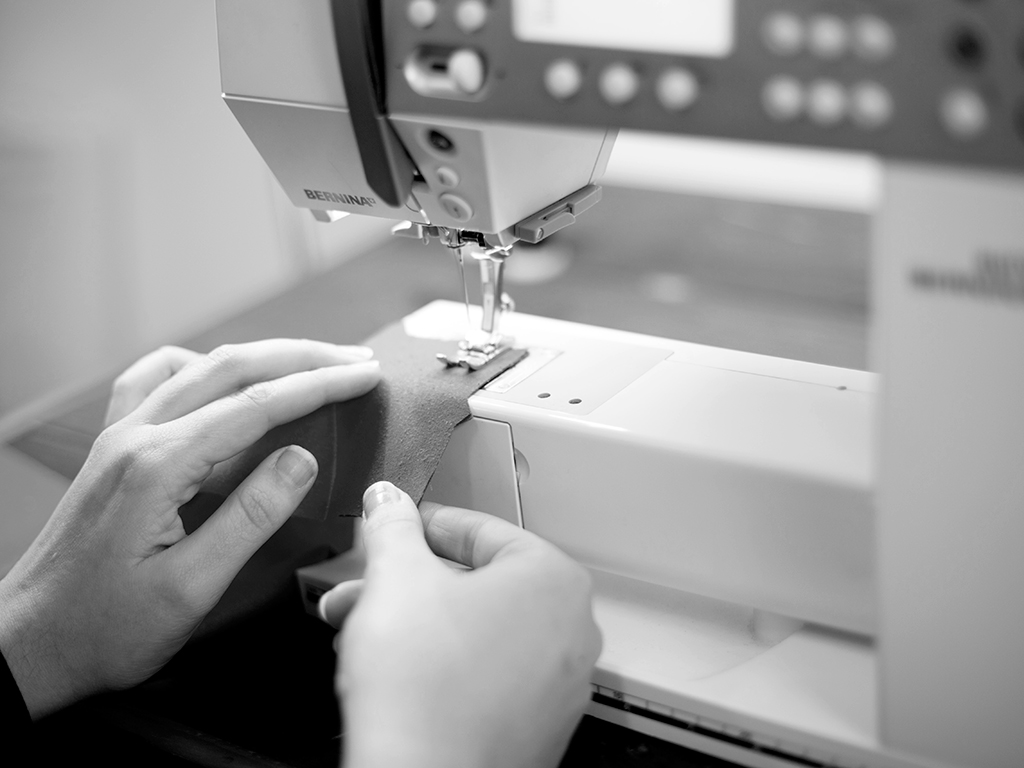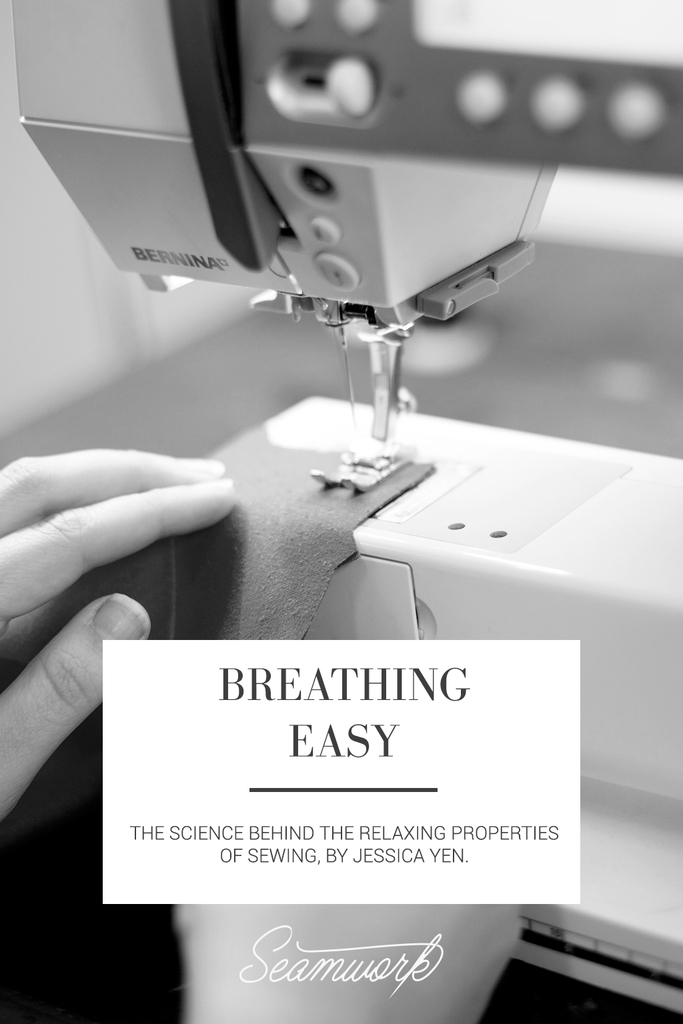
Poll a room full of sewists, and most will tell you they find sewing relaxing. We call it a therapy session, self-empowerment vehicle, and canvas for creative self-expression, all rolled into one. If you think about it, there’s nothing inherently relaxing about hunching over a sewing machine with little bits of thread and swaths of fabric for hours on end. If anything, most people would call that a recipe for frustration. So why do we say that sewing is so relaxing, and why is it the chosen method of de-stressing for so many of us?
Crafting and the Relaxation Response
One reason many people find sewing and knitting relaxing is because these activities can elicit the so-called relaxation response. This term was first coined by Dr. Herbert Benson, founding president of the Mind/Body Institute at Harvard Medical School, to refer to the body’s counterbalance to our physiological response to stress (commonly known as fight-or-flight). When the body is in fight-or-flight mode, heart rate, respiration, and pulse all increase, and blood flows into the skeletal muscles, heart, and lungs. Modern-day stress often activates this fight-or-flight response, and many of us exist in a constant state of heightened physiological activation as a result. Unfortunately, excessive activation of the stress response has been linked with disease, illness, and injury.
In contrast, the relaxation response activates the parts of the brain associated with digestion, blood pressure, and heart rate, such that breathing slows and stress hormone levels drop. When we enter into the relaxation response, our blood pressure also drops, and our heart beats more slowly. Furthermore, researchers have found that the relaxation response can counteract certain stress-related disease processes. “These are also the bodily functions that are often compromised by stress,” the health writer Cary Barbor observed in an article in Psychology Today(1). “It would make sense, then, that these modulating functions would help to ward off stress-related conditions such as heart disease, digestive problems, and infertility.”
Expanding the Definition of Meditation
Traditionally, the relaxation response has been associated with meditation and meditative activities like Buddhist walking meditation or traditional Native American ecstatic dancing. Lately, the definition of meditative practice has grown, as has the type of activities that scientists include in the definition of meditative practices. According to Dr. Benson, these activities all include two basic steps:
Repetition of a sound, phrase, or prayer. This can also include the repetition of an activity, like drawing a needle through fabric, making a knitted stitch, or even cutting patches of fabric for a quilt.
Awareness of one’s thoughts, in order to passively set them aside and return to the repetition.
Repetition is a key component of the relaxation response, because it appears to pull us into the present moment, which distracts us from falling into vortexes about the past or the future. The use of repetitive movements can be helpful for those of us who are too amped up to sit down and meditate, especially when these movements are associated with a pleasurable activity, like sewing or knitting. In this case, meditativeness becomes the side product and not the goal, yet we can still reap the same benefits.
Research on repetitive movements in animals has shown that these movements enhance the release of serotonin, a neurotransmitter associated with calm emotions. Repetitive movements can also produce a gentle motion of moving your eyes from side to side, which itself might also be helpful. Some therapists use “eye movement desensitization and reprocessing” to work with trauma victims, and many yoga and tai chi teachers also have students move their eyes from side to side as part of their practice.
Common Elements Found in Activities that Elicit the Relaxation Response
Psychiatrist Dr. Teresa Anderson calls knitting a form of active meditation, which means that it’s “something you can do and focus on, but it has a repetitive quality to it.” Characteristics that crafting shares with other meditative activities include:
- The activity is performed in a quiet environment.
- It enhances our ability to focus inwardly and concentrate on the demands of the specific task.
- It encourages disregard of everyday worries.
- It involves focused attention on a repetitive mental stimulus or activity
Additional Benefits of Crafting
Meditative activities stimulate the structure of the brain’s reward system, particularly the left frontal lobe, which has been correlated with mood elevation. When exposed to a stressful event or negative stimulation, highly practiced meditators can better maintain emotional equanimity, or even if they are thrown off balance, they more easily return to a state of emotional equilibrium. By regularly engaging in sewing or other meditative crafting activities, we can strengthen our ability to stay calm (or recover more quickly) during times of stress.
In addition to relaxing us and thus protecting us against stress, crafting can also make us happier. Technological advances in the last decade have allowed researchers to examine how the human brain operates while people engage in specific activities. Activities like sewing or knitting can release the neurotransmitter dopamine, which triggers the brain’s reward system. We thus associate crafting with pleasurable feelings. Scientists believe the original purpose of dopamine was to encourage us to repeat the activities that help species survive, like eating and having sex. Over time, though, our brains evolved so that dopamine is also released when we engage in other pleasurable activities, like crafting.
“Dopamine, in and of itself, is our natural anti-depressant,” says Catherine Carey Levisay, a clinical neuropsychologist and wife of Craftsy CEO John Levisay. “Any time we can find a non-medicinal way to stimulate that reward center…the better off we’re going to be.”
In addition, if you’ve ever found that just touching yarn or stepping into a fabric store makes you happy, it’s because the neurotransmitter glutamate can promote the association between the positive feelings invoked by a specific activity and its sensory cues.
Crafting can promote happiness in other ways, too. Seeing the finished product in your wardrobe, hearing positive comments about your handmade garment, or receiving gratitude for a custom-made gift are additional means through which crafting can stimulate feel-good neurotransmitters. Also, crafting can provide a social outlet for people who like to work in groups.
Getting the Most from Your Crafting
Peg Baim, the clinical director of the Mind/Body Institute, acknowledges that crafting is not always a meditative activity. We’ve all seen the knitters whose shoulders knot as they mutter about unfamiliar stitch patterns. Or the sewist who rushes through a project, staying up too late or stressing about finicky finishing details. She suggests that:
The key is to stay in a state of openness and to bring to your work an attitude of interest. Stay out of your judging mind.
In addition to bringing an attitude of interest, she also recommends identifying an intended focus at the start of a crafting session. This frame of mind can help sewists enter a state of deep, contemplative meditation. For instance, instead of worrying that you won’t finish your travel capsule wardrobe in time, instead try focusing on what you intend for the vacation: an opportunity to connect more deeply with friends or a partner, an extended period of time to gain perspective on life.
Even our least favorite aspects of sewing—for some this might be mending, for others it could be hand sewing—can still produce positive benefits. Perhaps the solution is to, again, focus on our intentions (the confidence that comes with a handmade wardrobe, or the self-sufficiency that comes with boycotting fast fashion). Or perhaps the solution is to call upon the benefits of social support by gathering friends together for an afternoon or evening of hand sewing or mending.
The next time you find yourself frazzled by a long, complex, or stubborn sewing project, take a step back, inhale deeply, and remind yourself of the benefits of crafting. Imagine all that dopamine, serotonin, and glutamate hovering just off-stage, waiting to light up the parts of your brain associated with happiness and calm. Center yourself around an intention for your sewing session, and focus on the repetitive motions. The process of sewing is just as good for us as the final results.
-
The Science of Meditation by Cary Barbor


